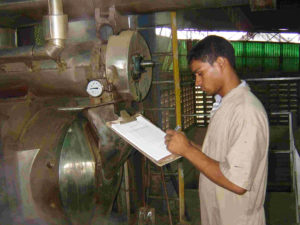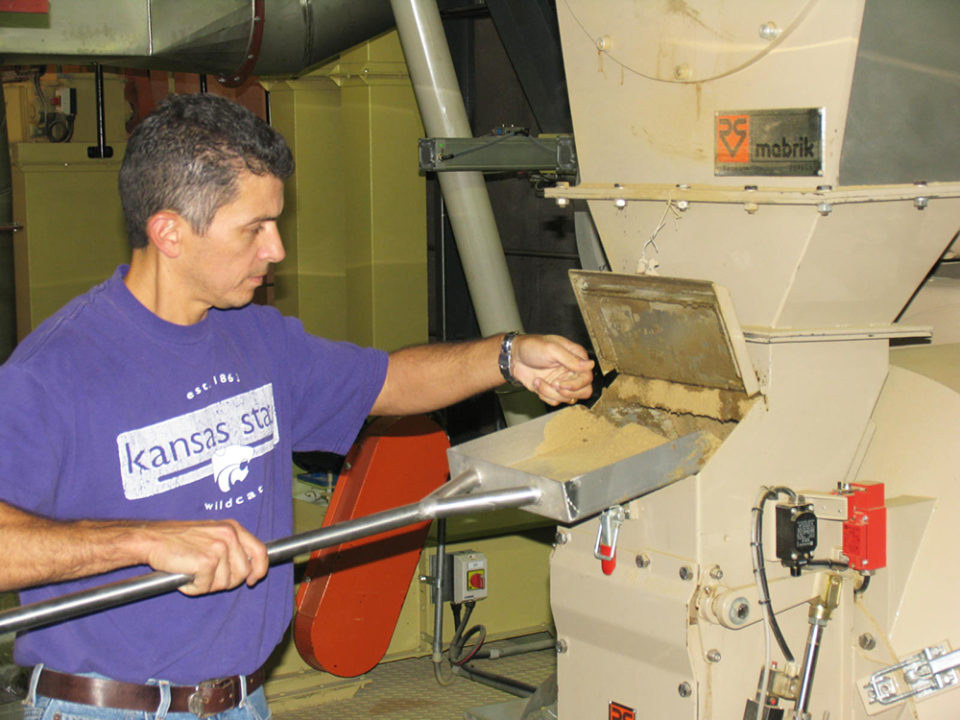Strict processing guidelines ensure top-quality pellets

In the Pelleting Cost Center, the ingredient mixture (formula) is placed in the holding bin above the pellet mill until it is pelleted. Pelleting is defined as the agglomeration process of a mash meal that is forced or extruded through a die. The force to extrude the mixed formula through the die is imparted by the rollers (as discussed previously) and the opposing force exerted (friction) by the forming die in the opposite direction of the flow. The resulting product, usually of cylindrical shape, is what we know as a pellet.
Pelleting line cleaning and sanitizing
As in the Grinding and Mixing Cost Centers, the pellet operator is responsible for controlling the process and ensuring that the product meets the quality standards. In the pelleting process the operator must first ensure that the line is properly cleaned and, if possible, sanitized. Prior to the start-up of the line, the operator must check the conditions of the pre-conditioner. Here is where the mash meal is subjected to steam, creating a hot and humid environment. An improperly cleaned pre-conditioner can be a reservoir for mold growth (aflatoxins) and other pathogenic microorganisms.
Therefore, it is very important that this unit be thoroughly cleaned by removing any build ups from the paddles, the walls of the chamber, and from any dead spots. If the pre-conditioner is equipped with steam jackets, these should be turned on to heat up the unit and dry any residues left therein. After drying its contents, the unit should be opened and cleaned thoroughly. This clean up and sanitation procedure should be carried out at least once a day to ensure that no moist organic matter is left in the pre-conditioner, which could be a source of cross contamination.
Often overlooked, but as critical as the pre-conditioner, is the mash meal holding bin. It is possible for steam being injected to the pre-conditioner to find its way to the holding bin. If this happens, the steam can condense on the walls of the bin and provide the moist, humid environment for pathogens to grow and thrive. Therefore, it is very important that the holding bin or surge hopper be equipped with inspection doors so they can be checked when empty for material build up and mold growth. Under practical conditions, the holding bin should be inspected at least once a week or whenever the operator has detected a situation where steam could have moved up from the pre-conditioner to the holding bin.

A good example of a case of steam moving to the holding bin can be explained when the operator runs out of material (mixed formula) in the bin and continues running the pre-conditioner. When the latter happens, steam can travel very easily upwards, since it is in a gaseous state through the feeder. The feeder, when running full of meal, forms a plug that prevents the steam from moving up (path of least resistance) to the holding bin.
Under empty conditions the steam then can easily move up to the holding bin and condense on the cold walls of the bin. This condensation will be in contact with the incoming meal, forming a layer or crust of moist material where microorganisms will grow. Therefore, when the operator runs into such a situation, he/she must record it on the control sheet, indicating the cause and the action required, which in this case, would be to clean up the holding bin.
It is also very important to check the screw feeder. This is the unit that provides material (mash meal) to the pre-conditioner and is located at the bottom of the holding bin, between the holding bin and the pre-conditioner. It is also possible to have material build up in the screw feeder. This build up can also be a source of cross contamination to the incoming meal. Because this unit is more difficult to open for inspections, the operator should request to the maintenance department a weekly check of the unit to ensure its cleanliness.
Material can not only build up in the screw feeder and the holding bin. As indicated before, material build up also occurs in the pre-conditioner paddles and walls. Therefore, it is important to start up with a cleaned pre-conditioner.
It is also important to check the pre-conditioner’s paddles configuration. The pre-conditioner paddles are adjusted to an angle (pitch) that provides the best amount of fill and residence time to allow the meal to be conditioned with steam (moisture and temperature time dependent process). Therefore, as the pre-conditioner cleanliness is being checked, the operator must also check the paddles configuration and ensure that they are in the specified angle with the forward or reverse pitch configuration.
Equipment checklist
Prior to starting the pelleting process, the operator must ensure that the following equipment is clean and in good working condition:
- Holding bin
- Feeder
- Pre-conditioner (paddle configuration, clean)
- Chute or transition between pre-conditioner and pelleting die (clean)
- Chute or transition between pellet mill and post-conditioner or dryer/cooler (no residues, material build up, lumps)
- Cleanliness of all conveying equipment
- Steam line (adequate pressure and no leaks)
- State of wear of knifes of the pellet mill
- State of wear of the deflectors (ensure even distribution of material on the die)
- State of wear and cleanliness of the feed cone
- Die: state of wear, cleanliness, plugged holes, worn out surfaces, pinned die surface, etc.
Control of processing conditions
Once the operator is sure that the pre-conditioner, holding bin and pellet mill are in good working order and clean, the process can be started. Upon starting, the operator must also collect samples of the mixed formula before the pre-conditioner and determine its moisture, temperature, and bulk density. The moisture content can be measured on site using infrared lamps. Once the process has started the operator must collect samples at the exit of the pre-conditioner and measure directly the temperature as well as the moisture. Based on the results of the measurements, the operator can make the necessary adjustments to the feed rate, pre-conditioner speed, and the steam addition in order to achieve the desired mash temperature and moisture.
All data collected must be properly recorded. Remember that if you start with a cold and low moisture mash meal, you will need more residence time in the pre-conditioner to achieve the target moisture and temperature. The operator could very well achieve a high temperature meal but without the adequate moisture content to form a good quality pellets that would be adequately water stable. Therefore, it is very critical to start with a mash meal of adequate moisture content and temperature to ensure that the specified operating conditions can be achieved. Mash meals too low in moisture will require long residence times in the pre-conditioner. Similarly, low temperature meals will require more energy to achieve the desired temperature and in most cases if achieved the moisture may be too high and could cause pellet die blockages.
The operator must also do periodical catch tests to determine the actual mass flow rate or productivity. This can be done at the exit of the pre-conditioner, where the flow of the hot meal is diverted out to a pre-weighed container for a period of 15-30 sec. The amount collected is weighed and recorded in the data sheet. This value is important because it gives the actual capacity of the pellet mill under the specified conditions in the process (mash temperature, moisture, residence time) to ensure consistent pellet quality. Any deviation above or below the optimum operating range can adversely affect the pellet physical integrity.

The bulk density of the material collected at the start of the process can be a good indicator that a specific formula is being used. Note that the bulk density of the mash meal will be affected by the ingredients in the formula, and also by the particle size. Therefore, if a mistake is made in the mixing operation, this can be detected downstream in the pelleting line simply because the bulk density for specified formula is out of range.
At the exit of the die, the operator should collect pellets and measure the pellet temperature and moisture. A sample should be collected during the process every 30 min. If the pellets are sent to a post-conditioner, the operator is also responsible for running this unit and should collect data like residence time, pellet temperature inside the unit, steam pressure (if applied), and pellet temperature at the exit of the unit.

The operator should also collect samples of the pellets exiting the cooler and record its temperature and moisture. The samples of pellets collected at the exit of the cooler should be sent to the Quality Assurance Lab so they can be subjected to water stability analysis, pellet durability index, and percent fines.
All parameters of interest that should be recorded during the pelleting process are presented in Table 1. Data collection should not be regarded only as the means to control the process under the specified parameters. It is also a tool to correlate processing conditions with product attributes such as pellet durability index, and water stability. It also can be a tool for the maintenance department to record the useful life of the die as it relates to quality (water stability, pellet durability, fines) and capacity reductions. In other words, it is a tool to maintain quality under control.
Perspectives
In the pelleting process, it is important to maintain strict processing guidelines to ensure the consistent production day-in-day-out of optimum quality shrimp feeds. Clean units of operation as well as optimum processing conditions can ensure the production of the best possible quality feeds that meet nutritional and physical standards of the target species.
Author
Tagged With
Related Posts

Aquafeeds
A look at the SME controlled extrusion process
A study was conducted using a Twin-Screw Extruder equipped with Specific Mechanical Energy (SME) and Density Control valves, to determine the effect of SME on the water stability of shrimp feeds. Further research is needed to evaluate the performance.

Aquafeeds
Mixing Cost Center is at the heart of feed manufacturing
Ingredients that are properly proportioned and mixed for an adequate mixing time are very important to assure the manufacturing of aquafeeds that meet the standards for the shrimp species and life stage for which the formula was designed.

Aquafeeds
Shrimp feeds depend on proper ingredient grinding
The proper feed particle sizes of aquafeed ingredients are established by the nutritional requirements of the species targeted and by the feed manufacturing process used. For proper ingredient particle sizes, various characteristics are very important, including particle size distribution and pellet density.

Aquafeeds
Optimizing crucial cost centers for shrimp feed manufacturing
Assuring that aquafeed ingredients are processed properly into a high-quality product requires monitoring each manufacturing process through the proper in-line quality assurance, to produce a consistent quality continuously.


